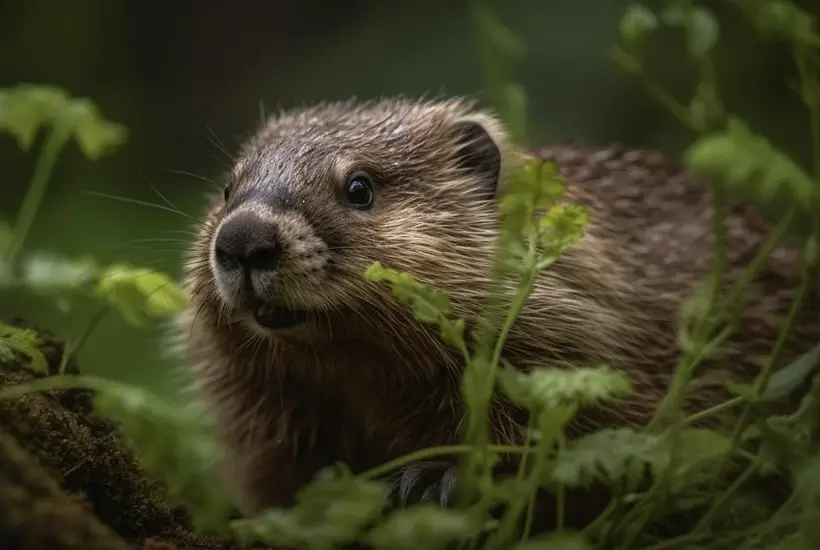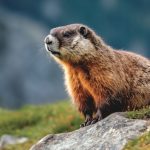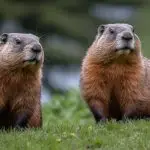What Do Marmots Eat? A Comprehensive Guide to Marmot Diets
Marmots are 15 species of important ground-dwelling rodents found worldwide. They play a vital role in their ecosystems. They face various threats like habitat loss, climate change, and disease. Understanding their diet is essential for their conservation, as changes in vegetation patterns and food availability can impact their survival.
By studying their diets, researchers can identify which plant species are most important for these animals. And prioritize habitat conservation efforts accordingly. Conservation of squirrels is crucial for maintaining healthy and functioning ecosystems.
This article delves into “what do marmots eat”, including their nutritional needs, food preferences, and seasonal variations. It also examines the impact of food availability on their population and behavior, and highlights the importance of understanding these factors for conservation and management efforts. It also focus on their wildlife habitats.
Overview of Marmot Diets
In this discussion, we will cover the diets of marmots, their digestive systems, and how they acquire nutrition. In addition, we will also discuss the significance of their diet in their survival.

Categorization Of Marmot Diets
Marmots are typically classified as herbivorous animals. The reason is the majority of the 15 species of marmots primarily consume plant-based diets.
There are a few exceptions of omnivorous species of marmots that consume some animal matter. However, these species still rely heavily on plant-based food.
Marmot food preferences
There are no known carnivorous species of marmot, but a few carnivorous ones are present.
- Herbivorous: Herbivorous animals are those that primarily feed on plant-based food sources. They include leaves, grasses, fruits, seeds, and grasses. These animals do not eat meat or animal-based products as a significant part of their diet (but there are exceptions).
Here are a few herbivorous species of marmots.
- Hoary
- Alaska
- Himalayan
- Long-tailed
- Bobak
- Siberian
- Black-capped
- Menzbier’s
- Tarbagan

- Omnivorous: Omnivorous refers to animals that consume both plant-based foods along with animal substances as a daily diet. In the marmot family, there are just two or three species.
- Olympic
- Vancouver Island
- yellow-bellied
Description Of Marmot Digestive System
These ground squirrels have a digestive system that helps them get nutrients from the plants they eat. They have strong teeth to cut and grind food. The salivary glands secrete enzymes. Which initiate the breakdown of carbohydrates in food. Their basic stomachs only have one compartment. Food that has been chewed mixes with the stomach’s acidic digestive juice when it enters the stomach.
After going through the stomach, it enters the intestine. The majority of the nutrients are absorbed by the bloodstream. The pancreas also aids in the breakdown of the protein there. Where most of them are digested.
The large intestine receives the final substances that were not digested. These substances contain bacterial and other microbial fermentation. which was then used as a source of energy. In the end, the anus is used to eliminate the feces.
These animals mostly eat plants, but they may also eat a little bit of meat or insects for extra nutrition.
Here is the pathway of marmots’ digestive system
Mouth → Stomach → Intestine → Cecum → Anus
Nutritional Requirements Of Marmots
Marmots need a diverse and balanced diet to survive and reproduce effectively. Being herbivorous animals, they mainly depend on plants like fruits, seeds, and leaves for nourishment. However, some species of marmots also consume small quantities of animal protein to fulfill their nutritional requirements.

The provided nutritional requirements serve as a sample for marmots. But it is important to keep in mind that these may not be suitable for all marmot species.
- 10-15% protein
- 3-6% fat
- 75-85% carbohydrates
- 25-30% dietary fiber.
Role Of Marmot Diets In Their Survival And Reproduction
Diet is the main arsenal of all living objects for their survival and reproduction. These groundhogs aren’t any different here. The impact of the diet of marmots is as follows.
- Offspring Development: The quality and quantity of food available to pregnant and lactating females directly impact the growth and survival of their offspring.
- Survival and Reproductive Success: Dietary flexibility is crucial for the survival and reproduction success of marmots. As it allows them to adapt to changes in food availability and quality across different seasons. They quickly adapt to the diet required for that condition.
- Food Storage: This squirrel stores food in underground burrows during summer to survive the rest of the winter when food is scarce. The quality and quantity of food available during summer directly impact their ability to accumulate enough fat stores for hibernation.
Favorite Foods of Marmots
Marmots have a diverse diet, consisting mainly of vegetation such as grasses, herbs, leaves, and flowers. Some species also eat insects like ants and beetles. Their dietary flexibility allows them to adapt to changes in food availability and quality. It ensures their survival in their alpine habitats.

Here Are A Table For Marmot’s Favorite Foods
Here is a short Marmot diet chart. This table shown examples of the diet of marmots and the nutrients they absorb from it.
| Food Type | Examples | Nutrients |
|---|---|---|
| Insects | Grasshoppers, beetles, caterpillars | Protein |
| Roots and Tubers | Lupine, arrowleaf balsamroot | Nutrients, carbohydrates |
| Seeds | Lupine, sunflower seeds, grass seeds, paintbrush seeds | Protein, healthy fats, fiber, micronutrients |
| Wildflowers | Dandelions, clover | Vitamins, minerals |
| Grasses | Bluegrass, fescue, timothy grass, needlegrass, wheatgrass | Fiber, protein, micronutrients |
| Bird Eggs | Any available | Protein, micronutrients |
- Insects: Some species of marmots consume small amounts of insects, including grasshoppers, beetles, and caterpillars. Insects provide high protein, which is essential for their overall health.
- Roots and Tubers: This ground squirrel enjoys feeding on roots and tubers from various plants, such as lupine and arrowleaf balsamroot. These underground plant parts provide essential nutrients and carbohydrates.
- Seeds: Marmots feed on seeds from various grasses and flowers, such as lupine, sunflower seeds, grass seeds, and paintbrush. These seeds provide them with a source of protein and other nutrients
- Lupine: Lupine seeds are a good source of protein and contain micronutrients like iron, calcium, and phosphorus.
- Sunflower seeds: Sunflower seeds are high in healthy fats, protein, fiber, and micronutrients like vitamin E and magnesium.
- Grass seeds: Grass seeds are a good source of carbohydrates and fiber, with some protein and micronutrients like iron and zinc.
- Paintbrush seeds: Little is known about the nutrient content of paintbrush seeds, but they may contain similar nutrients to sunflower seeds as they are part of the same plant family.
- Wildflowers: Marmots forage for wildflowers, such as dandelions and clover. Wildflowers provide them with a source of essential nutrients, including vitamins and minerals.
- Grasses: Marmots consume a significant amount of grasses, particularly bluegrass and fescue. They also consume grasses like-
- Timothy grass: A popular forage crop for livestock, high in fiber, and a good source of energy. It also contains micronutrients like calcium, potassium, and magnesium.
- Needlegrass: A type of bunchgrass found in grasslands and prairies, drought-tolerant and high in fiber. In addition, it’s a good food source for grazing animals.
- Wheatgrass: Consumed as a health supplement due to its high nutrient content. This is another great source of vitamins A, C, and E and minerals such as calcium and iron.
- Bluegrass: Common lawn grass and forage crop for livestock, high in fiber and protein, and contains micronutrients like potassium and phosphorus.
- Fescue: Cool-season grass for grazing and hay production, high in fiber and protein, contains micronutrients like copper, zinc, and selenium, but some varieties can be toxic to livestock.

- Bird eggs: Although it’s not common, few species are sometimes likely to have bird eggs.
- Stems: These groundhogs also consume stems from various plants, such as daisies and yarrow. These stems provide fiber, vitamins, and minerals, which are essential for their overall health.
How Do Marmots Locate And Extract Nutrients From Their Food?
Marmots do these in many ways. They are as follows.
- Grinding and crushing: This is the most common way a rodent-like marmot extracts nutrients from their food.
- Coprophagy: This squirrel participates in a habit known as coprophagy, eating their own feces. This may seem unhealthy, but it allows them to extract more nutrients from their food.
- Bacterial fermentation: They ferment plant material in their stomachs with the help of gut bacteria. This process breaks down tough fibers and enables them to extract more nutrients from their food.
- Cud chewing: These groundhogs spew partially digested food and re-chew it to further break down the plant. This way, they extract more nutrients from their food.
Seasonal Variations in Marmot Diets

With a variety of food sources available all year long, the diets of this animal change with the seasons.
Overview Of How Marmot Diets Change With Seasons
Marmots eat differently depending on the season. This helps them stay healthy and strong.
In spring, they eat new grass and flowers. In summer, they eat leaves, roots, and seeds. In the fall, they eat a lot to prepare for winter, and in winter, they live off stored fat. Sometimes they might eat frozen plants. This way of eating helps them to survive in their natural habitat.
Typical Marmot Diets During Different Seasons
We will describe how the diet of this animal varies throughout the year, covering the interests of all four seasons.
- Spring: Marmots primarily eat early spring greens with low fiber and high nutrients for reproduction. They may also consume roots when leaving hibernation. New grasses, flowers, and young shoots of plants are on their diet list too.
- Summer: Marmots browse widely during summer and consume a variety of plant parts, including flowers, fruits, leaves, and stems. They also eat leaves, roots, and seeds.
- Fall: Marmots forage for foods with high carbohydrate content, such as seeds, roots, and tubers. They may also eat bark or twigs from trees when other food sources become scarce. They don’t refrain from eating insects, small animals, and nuts as well.
- Winter: They barely eat anything during hibernation. However, they mostly rely on stored fat reserves for energy. Here are some wintertime foods that marmots may eat.
- Frozen plants
- Bark from trees.
How Seasonal Variations In Marmot Diets Affect Their Behavior And Ecology
Here are how seasonal variations in marmot diets affect marmot behavioral and ecological aspects.
- Behavioral Changes: The behavior of marmots changes with the seasons. They move to find food in spring, stay near their burrows in summer, and eat more in fall.
- Hibernation: Marmots store fat in the fall to survive winter hibernation. They come out of hibernation in spring to start eating again.
- Ecological Impact: Marmots affect the plants they eat, and their behavior affects predators. Changes in marmot populations can affect the entire ecosystem of marmots’ surroundings.
FAQs
Here are a few questions and answers regarding marmots’ diet.
Do marmots eat meat?
It’s true that while some marmot species occasionally consume meat, their main diet consists of plants, leaves, and seeds. When they do consume meat, it is mostly in the form of different types of insects, such as beetles, grasshoppers, and caterpillars.
Additionally, some marmot species have been known to consume bird eggs on occasion
Can marmots eat human food?
Whether marmots can eat human food depends on the type of food. If human food is plant-based, such as common vegetables like lettuce, spinach, or cabbage, then yes, marmots can eat them. However, if the food is processed, such as biscuits, crisps, or burgers, then no, marmots typically do not eat it.
What do marmots drink?
Marmots don’t need to drink like other rodents. Marmots get most of their water from the plants they eat. They can conserve water well but will drink when available from streams, ponds, snowmelt, or man-made sources. They may also get water from morning dew or other sources of moisture.
How much do marmots eat in a day?
Generally, on average, an adult marmot may consume about 15-20% of its body weight per day. During hibernation, marmots do not eat at all. Baby marmots, or pups, consume milk from their mother for the first few weeks of their life.
As they grow and begin to explore their environment, they may start to nibble on small amounts of solid food, but that’s not more than 10% of their weight.
Conclusion
Marmots are primarily herbivorous. And their diets vary depending on their habitat and seasonal availability of food. Their main diets are grasses, herbs, and shrubs, but they may also occasionally eat insects and small mammals.
Future studies could investigate the dietary preferences and nutritional needs of various marmot populations and assess how changes in food availability affect their behavior and health.
Such research would deepen our understanding of marmot ecology. This, in turn, would inform management strategies aimed at conserving these animals and their habitats.




